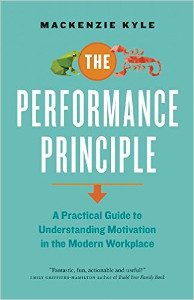Canadian executive shares management insights in novel style non fiction book
Posted by Elena del Valle on January 19, 2017

The Performance Principle
Photos: MNP
After Making It Happen, his first non fiction title, was published, Mackenzie Kyle, managing partner for Advisory Services in British Columbia, Canada for MNP, a consulting and accounting firm, he discovered he liked to write and wanted to work on another one. As a result The Performance Principle A Practical Guide to Understanding Motivation in the Modern Workplace (Figure 1 Publishing, $21), was published in 2016. It took four years from his first typed page until it appeared in print.
Written in the form of a novel The Performance Principle features the story of Will Campbell, a newly promoted executive of a firm which has fallen on hard times. Over the course of several tumultuous months, Campbell and his team learn the principles of performance management and the powerful results it can deliver. Kyle’s target audience? Anyone tasked with managing people, from people supervising one other person, to senior managers responsible for large teams. He believes that the ideas in the book are helpful for individuals interested in working more effectively as part of a team; that it can help them to better understand their own motivations, and work more effectively with other teams members.
“My motivation was really two-fold,” Kyle said by email when asked what prompted him to write the second title. “I was looking for an alternative way to communicate a number of ideas around performance management, and I’d had good success with this approach with my previous book (which dealt with project management.). The second reason was fairly personal – I like the writing process, and tackling The Performance Principle was an excuse to do something work-related, that also allowed me to do some creative writing.”
The new book is a sequel to the first book, sharing most of the same characters, who a number of years later are facing some new challenges. The author explained that there is sufficient information about the back story in the new book so it is not necessary to read the first book. At the same time, his approach was similar in both books. The protagonist (Campbell) is the focal point for uncovering the underlying issues, and his sage (his mother-in-law) is the character that brings the ideas about performance management to the team. Kyle wrote the story to help the reader walk through the implementation of the ideas in a (relatively) realistic situation.
When asked why he wrote it in the form of a novel he replied, “I’ve found that wrapping a story around a set of ideas can be a more interesting (some would only go as far as ‘less painful’) way of getting those ideas across. It also provides some context in which people can ‘see’ the ideas in action. I really enjoy the creative writing process, and the challenge of putting the ideas into a story or case study was something I found to be personally interesting (and enjoyable). I keep looking for that job ad for a ‘full time novelist’ but so far haven’t seen it.”

Mackenzie Kyle, author, The Performance Principle
“While I don’t address introverts and extroverts specifically as personality types in the book, I do talk about the reality that different people find different things motivating (or punishing), and how work with that,” the author said when in response to a question about the relevance introvert and extrovert personalities have on the topic. “Recognizing these differences is key to working effectively with a team, and essential for a manager. For example, someone we characterize as an extrovert might find public recognition very rewarding for doing a good job on a particular task; someone we might call an introvert would actually find being singled out in front of the group to be punishing. As a result, they might avoid doing whatever it is that gets them that recognition, even if it’s not the performance we’re looking for.
One caveat though, and that is to avoid pigeonholing people into one category or another. For example, very few are pure extroverts or pure introverts. Instead, they will usually lean toward one side, but have characteristics of the other. This means everyone needs to be treated as an individual when determining what he or she find motivating. Broad generalizations can result in missing the mark, and ultimately less effective performance.”
Kyle has more than 25 years of experience in operations improvement and restructuring, and has provided specific assistance in everything from strategic planning to performance management to managing projects. He has worked in manufacturing, transportation, telecommunications, and the public sector, and internationally in the United States, Australia, New Zealand and Asia.

Click to buy The Performance Principle









